At the time of writing, we are on our very last day in Mexico. These blog posts will be slightly delayed depending on wifi-access, time and energy, so for shorter and more recent updates I recommend you to head over to my instagram account.
But let’s get to it! This will be the first of two parts about Mexico. I’ll try not to let it get too long, but if you’ve been around for a while you know that it probably will. Overall we’ve really enjoyed our time here. Some overall impressions:
- The public transportation is great, even if I sigh every time they put on a dubbed movie without subtitles (which is always, by the way). Long distance buses are easy to book in advance and timely. Colectivos and local buses are usually very easy to use and cheap.
- The food has been mostly great, though we gave up on trying to go for a completely pescetarian diet after only a few days. We’ve tried as many local dishes and drinks as we could, but still we keep seeing new things on the menus. Ordering the same thing at two different places can bring you very different results, which means sometimes you will be thrilled, and sometimes you will be disappointed.
- On top of that, we’re still not really used to the size of drinks as they are often served in huge glass goblets or styrofoam cups, and rarely smaller than 0,4 liters.
- Opening hours are also something that continues to confuse us, as many things are closed on Sundays, Mondays or Tuesdays, or any combination of those.
- Mostly we get by just fine with our basic Duolingo-Spanish. Occasionally we make an educated guess on what people are trying to tell us by interpreting single words, context, gestures or just gut feeling :D
- I really enjoy the breakfast food here. Especially chilaquiles (as seen on the photo below) and huevos rancheros.
But let’s get to the specific places, and the first one is of course Cancún, where we flew in a spent just a few days in order to recover from the jetlag. We found Cancún to be a strange city. Not so appealed by the idea of the Hotel Zone – a 20km long sand strip packed with huge hotels and resorts – we opted to stay in the centro. However, it didn’t feel like there was much of a city center. It was all huge roads with little traffic. We did find a plaza that had some food stalls, which is where we had our first taste of tacos, panuchos, empanadas, burritos, licuados and agua fresca. One day we took a bus over to a park that was supposed to have some animals and birds (plus, nice to just walk around among trees) but it turned out to be closed on Sundays – which unfortunately incuded the new year’s day as well.
 |
| chilaquiles for breakfast |
Another day we took the local bus out to the Hotel
Zone to spend some time on Playa Delfines – a nice beach, especially if you
get there early before the masses arrive. Just taking the bus itself through
the Hotel Zone is kind of a bonus sightseeing tour, although they drive
like crazy and the buses are barely keeping together. It also became clear to us
that in terms of covid and precautions, mask-wearing, hand sanitizing and
temperature checks are everywhere, but there is absolutely no social
distancing, especially in public transportation where the bus or minivan is not
full until every inch of the floor is filled with people.
Our first stop after Cancún was Valladolid, which is the classic starting point to visit the Maya ruins of Chichén Itzá. It’s a quite cute city with colorful colonial square houses, a big plaza and plenty of churches. As check-in time is normally at 3pm, wandering around the town looking at buildings and churches is quite a nice pastime. Valladolid was full of tourists, more than we expected, and quite lively. We found a nice foodcourt which worked for both breakfast, lunch and dinner, and occasionally we wandered around the streets in search of a restaurant or a café. Turns out the food court can sometimes have great and cheap food, but do not go there for your coffee! We thought we would order café con leche with our breakfast but what we received was quite literally the opposite – a styrofoam cup with hot milk and a jar of nescafé on the side. Luckily we found the cute café Kux Tal which served great coffee – well worth the walk.
Of course, we took the opportunity to go to Chichén Itzá. As we followed the instructions of guide books and internet, it did not tell us that the parking lot for the colectivos (minivans) had moved, but thankfully some locals could point us in the right direction as we wandered around at 7am. If you are reading this in/after 2022, the parking lot is on the same street as the ADO bus terminal, just a bit further down. While the site of the ruins doesn’t open until 8am you want to get there even before that to start queuing for the entrance. Naturally, because it's touristy, there’s a Starbucks where you can get some coffee while you wait in line. We were quite happy to be able to explore all of the ruins at our own pace before the huge busloads of tourists arrive and fill up the area. It also allowed us to wander around most of the site before all the vendors had opened up their shops and started calling out to passing tourists to buy souvenirs. It was really nice walking around these old temples and ruins, though we felt we had seen all of it in less than two hours, so we were quite early back in Valladolid again.
Another day
we rented bicycles to go visit some cenotes – big sinkholes filled with water
where you can swim. We really enjoyed the bike rides even though the bikes themselves were not the most fancy. As soon as we got out of the city, there was a good bike road all the way to the cenotes. While the cenotes were very pretty, we were unfortunately a little bit
disappointed as they were of course also very touristy. Apparently there is some general rule that you need to wear a life vest in order to swim in the cenotes, and this is not alway included in the entrance fees - it felt more like a way for them to earn more money, than something that was required from a safety perspective, but maybe there is a good reason for it.
We did find a nice restaurant in Valladolid, La Selva, which also happened to serve excellent margaritas with a bit of chili salt. We also tried the famous chelada & michelada drinks, but were a bit sceptical - while they got better towards the bottom of the glass, we prefer the beers as they are.
 |
| Margarita |
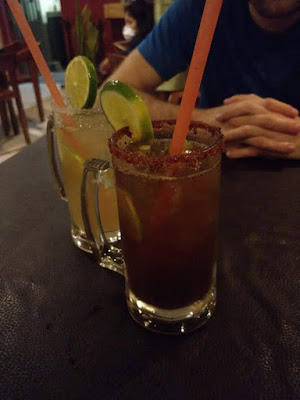 |
| Chelada & Michelada |
Originally, we were looking to go from Valladolid to Isla Holbox, but it seemed most of the budget accommodations were already fully booked, so instead we ended up going to Río Lagartos. It's a very small, but cute, fishing town by the water where pelicans, frigates and other seabirds are plentiful. Strolling along the water (or even on random streets in town) people will try to sell you boat tours. We had a really cute accomodation at El Faro ("the lighthouse") with a private room on the roof of a building. Unfortunately, our terrace was overlooking the town rather than the water, but it was still very nice.
The main attractions in Río Lagartos are of course the boat tours, so we booked one of those for 300 pesos (roughly 150sek). The boat tour includes a few different things: stopping for some photos of pelicans and seabirds (not super exciting as you can get plenty of those in town as well); finding one or two crocodiles in the mangrove; trying to scout some other cool birds from the boat (there are about 400 different bird species in Río Lagartos, though you probably want to pay for a proper guide if you want them pointed out to you); going to a shallow area to see some flamingos; stopping at a beach with white mud "Maya baño" that you can apply to your skin (it has some sulfur and is supposed to be rejuvenating for the skin); lastly a long boatride back (when the mud really dries in) to a beach where you can go for a swim and wash it off. I will say honestly the best part of the tour was to see the flamingos - although you can sometimes see a few of those flying by the town too. It was a nice tour, but not amazing.
The very best part of Río Lagartos, which we experienced the next day, was an area just east of town, easy to walk or bike to. An area called Sendero Petén Mac, and the Cenote Chekila. In this area there was a short wooden walkway into a mangrove forest, with a small "pond" where you can see crocodiles. As we walked here in the morning, we saw two of them sleeping in the sun - lying so still we nearly thought they were fake! We were also completely alone there which made a great opportunity to get some photos of them. When we walked over to the cenote, which was just by the ocean, we spotted another croc, with a snowy egret nearby. A local man told us that they have two different species of crocodiles in Río Lagartos, and that this was the smaller kind. They lie in the sun with their mouth open to clean the bacteria of their teeth, and occasionally the egret might help by picking their teeth - a risky hobby it might seem!
Overall we really enjoyed our stay in Río Lagartos, and especially going to that small area outside of town that I'm sure a lot of tourists miss out on. Unfortunately, it seemed the town was not at its peak as most of the restaurants and food stalls (as well as some hotels) were closed. At first we thought it might be because it was Sunday, Monday or simply too early in the day, but seemed like most were permanently closed. My best guess is that it was a lot more lively 2-3 years ago before covid. Most tourists that come here only go on day tours from nearby cities rather than stay the night. But if you're looking for something relaxed, it's a nice place to spend some time by the ocean, watch locals fish for shrimp at night, and maybe take the opportunity to eat some nice fish and seafood dishes.
Our next stops in Mexico were Mérida, Bacalar, Mahahual and Palenque - which brought some museums, kayaking, scuba diving, beach time, waterfalls and more Maya ruins. More about that in the next post!
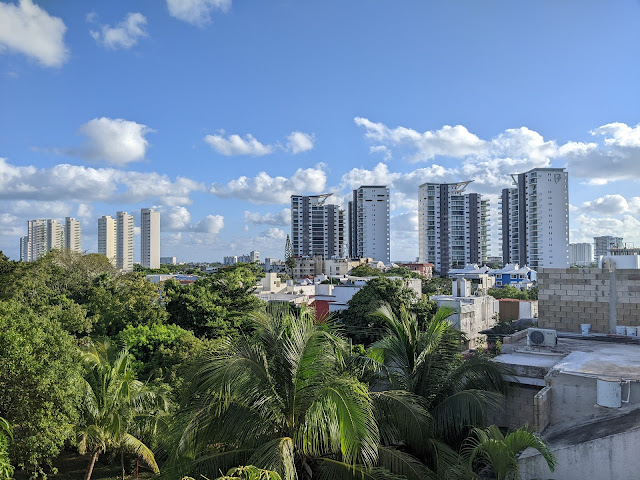






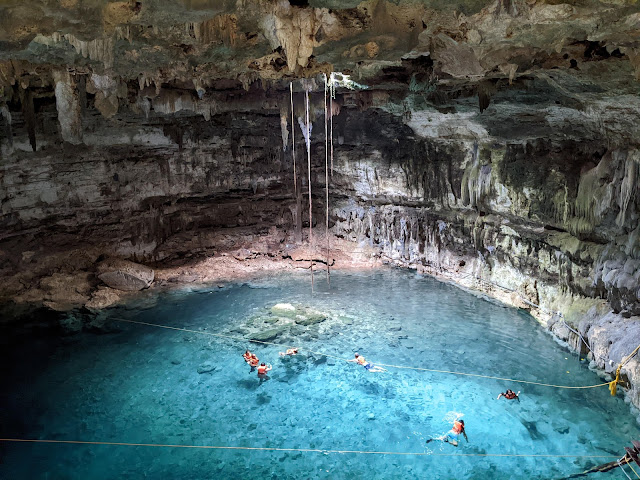


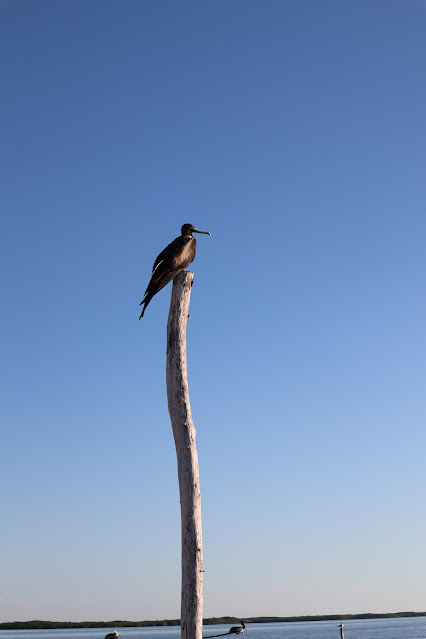





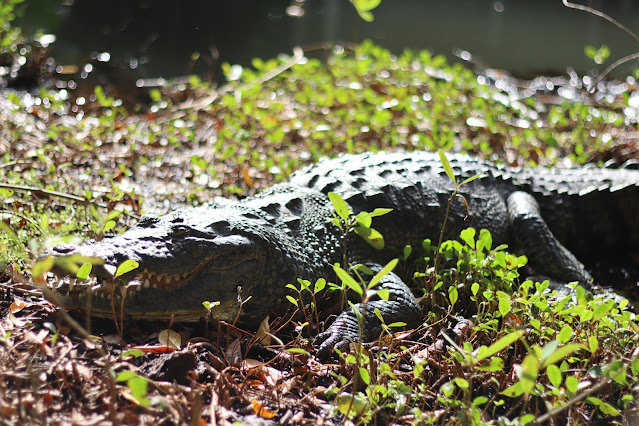

Inga kommentarer:
Skicka en kommentar